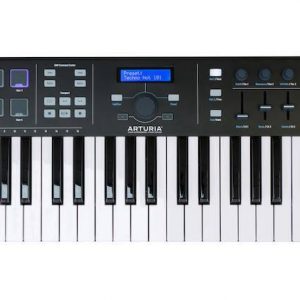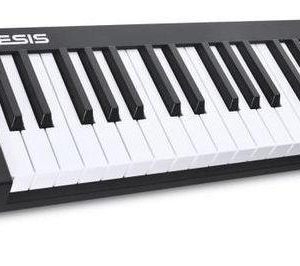M-Audio Keystation 88es
$126.99
Enjoy the ultimate piano playing experience with M-Audio Keystation 88es, a versatile and intuitive midi keyboard that brings out the best of your musical talents.
Compare
Description
The M-Audio Keystation 88es MIDI device is a powerful and versatile instrument that offers an exceptional playing experience. It is perfect for anyone looking to create music, whether you are just starting out as a beginner or a professional musician. This MIDI keyboard is designed to cater to all the needs of its users, from its responsive keys to the inbuilt software.
The M-Audio Keystation 88es boasts 88 semi-weighted keys, which are perfect for playing any type of music, be it classical, pop, or jazz. The keys offer a natural feel, just like an acoustic piano, making playing effortless and enjoyable. This is possible because the keys use a semi-weighted design, which allows for better control and responsiveness.
This MIDI device is incredibly easy to set up and use, thanks to its plug-and-play functionality. Once you plug it into your computer, you can start playing almost instantly, without any need for drivers or extra software. This means that you can start creating music almost immediately using this powerful device.
The M-Audio Keystation 88es also comes with a range of inbuilt software and features that help music producers and composers to create music easily. The software includes a wide range of virtual instrument plugins, which offers a selection of sounds such as electric pianos, strings, and bass. The software also includes a digital audio workstation (DAW), which allows you to record, edit, and mix your music easily. This helps you to create music without having to purchase additional software, which can be expensive and complicated to use.
One significant advantage of the M-Audio Keystation 88es is its compatibility with most operating systems and software. It can work with both Mac and Windows operating systems without any compatibility issues. This means that you can use this device with different software depending on your preferences.
In conclusion, the M-Audio Keystation 88es MIDI device proves to be a reliable MIDI keyboard for all music lovers. Its easy set-up, plug-and-play functionality, and compatibility with various applications make it a great addition to any musician’s gear collection. Whether you are starting out or a professional, the M-Audio Keystation 88es has everything you need to create and play different kinds of music effortlessly.
M-Audio Keystation 88es properties
| Product name |
Keystation 88es |
| Brand |
M-Audio |
| Type |
Keyboard Instruments |
| Keyboard Instrument |
MIDI Keyboard |
Frequently Asked Questions:
What are the basic steps to connect my M-Audio KeyStation 88 ES to a computer via USB and install the required drivers for it to function properly with my digital audio workstation?
Here are the steps you need to follow to connect your M-Audio Keystation 88 ES to a computer via USB and install the required drivers for it to function properly with your digital audio workstation:
1. Turn off the computer before connecting any cables or devices. This is important to prevent any damage that may occur due to electrical interference or static discharge.
2. Connect the M-Audio Keystation 88 ES to the computer using the USB cable provided with your device. The USB port on the back of the KeyStation should face up, and you should insert the connector into the USB port on your computer. Make sure the connection is secure by gently pulling on the cable to ensure it's plugged in properly.
3. Turn on the computer. After connecting the device and powering on the computer, wait for a few moments to allow the operating system to recognize the new hardware. If you're prompted to install drivers or firmware during this process, follow the instructions provided by your computer's operating system.
4. Install the M-Audio USB drivers:
- For Windows users, you can download and install the latest drivers for your Keystation 88 ES from the M-Audio website at [https://www.m-audio.com/support/sound_cards_and_interfaces/keystation_88_es#downloads]. Select "Windows" as your operating system, then scroll down to find and download the appropriate driver for your computer's bit depth (32 or 64-bit).
- For macOS users, the Keystation 88 ES is a class-compliant device that should work without any additional drivers. However, you may want to install the M-Audio Uno software to access additional features and enhance compatibility with your DAW. To do this, visit the [M-Audio Uno Software Download Page](https://www.m-audio.com/support/software/uno) and follow the instructions provided for macOS.
5. Connect your MIDI controller to your Digital Audio Workstation (DAW):
- Launch your DAW software, such as Ableton Live, Logic Pro X, or Pro Tools, and open a new project or session.
- In the preferences or settings menu of your DAW, locate the MIDI input/output section and make sure that the Keystation 88 ES is selected as the primary MIDI input device. This ensures that the software recognizes your controller when you play notes or use other controls on it.
6. Test your connection: Once everything is set up, try playing a note on your keyboard or adjusting a control to make sure that your DAW is receiving and responding to the signals from your Keystation 88 ES. If everything works as expected, you're ready to start creating music with your new MIDI controller!
If you encounter any issues during this process, consult the user manual provided by M-Audio or reach out to their technical support team for further assistance.
How does the aftertouch sensitivity function on the M-Audio Keystation 88es differ from traditional keyboard touch response?
The aftertouch sensitivity function on the M-Audio Keystation 88es goes beyond traditional keyboard touch response by allowing for expressive control over sound parameters even after a key has been released. This means that you can continue to shape and manipulate your sounds based on how hard or soft you press on the keys, adding another dimension of expression and nuance to your performances. Traditional keyboard touch response, on the other hand, only affects the volume or tone of a note based on the initial force applied to the key.
How does the M-Audio Keystation 88es' semi-weighted keys and velocity sensitivity contribute to enhanced expressivity in music production using a MIDI keyboard in a shop setting?
The M-Audio Keystation 88es' semi-weighted keys and velocity sensitivity allow for heightened levels of expression in music production when used with a MIDI keyboard in a shop setting. Semi-weighted keys offer a balance between the light, synthetic feel of synth-action keys and the heavier touch required for pianos, providing a more natural playing experience. Velocity sensitivity, meanwhile, allows for nuanced control over volume levels based on how hard or soft the keys are pressed, adding depth and variation to performances and recordings alike. These features make the Keystation 88es an excellent choice for musicians seeking enhanced expressivity in their music production endeavors, whether working in a professional recording studio or at home in a personal setup.
What are the specific steps to configure a Mackie HUI protocol on a M-Audio Keystation 88es for seamless integration with a digital audio workstation?
Configuring a Mackie HUI protocol on a M-Audio Keystation 88es involves a few steps. First, you'll need to ensure that your DAW is set up to work with the HUI protocol. Most modern DAWs support this protocol out of the box. Next, you'll need to configure the MIDI settings on both your keyboard and your DAW. Connect your Keystation 88es to your computer via USB. Open your DAW and go to its MIDI settings or preferences section. Set the MIDI input device to the M-Audio Keystation 88es. Ensure that the HUI protocol is selected in the MIDI settings of your DAW. On your keyboard, you'll need to enable the HUI mode by pressing a combination of buttons while powering it on. The exact steps may vary depending on the specific model and firmware version of your Keystation 88es. Press and hold the "Shift" button. Press the power button. Release the "Shift" button but keep holding the power button until you see the display turn on. While still holding the power button, press the "Menu" button to enter the settings menu. Use the up/down arrow buttons to navigate to the MIDI settings section and select it. Choose the HUI protocol from the available options. After completing these steps, your Keystation 88es should be configured for seamless integration with your DAW via the Mackie HUI protocol.
Before you buy M-Audio Keystation 88es







Reviews
There are no reviews yet.